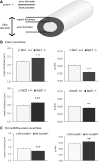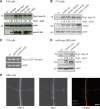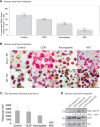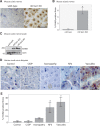Neuronal merlin influences ERBB2 receptor expression on Schwann cells through neuregulin 1 type III signalling
- PMID: 24309211
- PMCID: PMC3914471
- DOI: 10.1093/brain/awt327
Neuronal merlin influences ERBB2 receptor expression on Schwann cells through neuregulin 1 type III signalling
Abstract
Axonal surface proteins encompass a group of heterogeneous molecules, which exert a variety of different functions in the highly interdependent relationship between axons and Schwann cells. We recently revealed that the tumour suppressor protein merlin, mutated in the hereditary tumour syndrome neurofibromatosis type 2, impacts significantly on axon structure maintenance in the peripheral nervous system. We now report on a role of neuronal merlin in the regulation of the axonal surface protein neuregulin 1 important for modulating Schwann cell differentiation and myelination. Specifically, neuregulin 1 type III expression is reduced in sciatic nerve tissue of neuron-specific knockout animals as well as in biopsies from seven patients with neurofibromatosis type 2. In vitro experiments performed on both the P19 neuronal cell line and primary dorsal root ganglion cells demonstrate the influence of merlin on neuregulin 1 type III expression. Moreover, expression of ERBB2, a Schwann cell receptor for neuregulin 1 ligands is increased in nerve tissue of both neuron-specific merlin knockout animals and patients with neurofibromatosis type 2, demonstrating for the first time that axonal merlin indirectly regulates Schwann cell behaviour. Collectively, we have identified that neuronally expressed merlin can influence Schwann cell activity in a cell-extrinsic manner.
Keywords: Schwann cell; axon; merlin; myelination; neuregulin 1; neurofibromatosis type 2; polyneuropathy.
Figures







Similar articles
-
A neuronal function of the tumor suppressor protein merlin.Acta Neuropathol Commun. 2014 Jul 12;2:82. doi: 10.1186/s40478-014-0082-1. Acta Neuropathol Commun. 2014. PMID: 25012216 Free PMC article. Review.
-
Neuregulin-1 type III knockout mice exhibit delayed migration of Schwann cell precursors.Biochem Biophys Res Commun. 2017 Apr 29;486(2):506-513. doi: 10.1016/j.bbrc.2017.03.074. Epub 2017 Mar 18. Biochem Biophys Res Commun. 2017. PMID: 28322798
-
Merlin status regulates p75(NTR) expression and apoptotic signaling in Schwann cells following nerve injury.Neurobiol Dis. 2015 Oct;82:114-122. doi: 10.1016/j.nbd.2015.05.021. Epub 2015 Jun 6. Neurobiol Dis. 2015. PMID: 26057084 Free PMC article.
-
Merlin isoform 2 in neurofibromatosis type 2-associated polyneuropathy.Nat Neurosci. 2013 Apr;16(4):426-33. doi: 10.1038/nn.3348. Epub 2013 Mar 3. Nat Neurosci. 2013. PMID: 23455610
-
Neuregulin, a factor with many functions in the life of a schwann cell.Bioessays. 2000 Nov;22(11):987-96. doi: 10.1002/1521-1878(200011)22:11<987::AID-BIES5>3.0.CO;2-5. Bioessays. 2000. PMID: 11056475 Review.
Cited by
-
Tumor Biology and Microenvironment of Vestibular Schwannoma-Relation to Tumor Growth and Hearing Loss.Biomedicines. 2022 Dec 23;11(1):32. doi: 10.3390/biomedicines11010032. Biomedicines. 2022. PMID: 36672540 Free PMC article. Review.
-
Merlin controls the repair capacity of Schwann cells after injury by regulating Hippo/YAP activity.J Cell Biol. 2017 Feb;216(2):495-510. doi: 10.1083/jcb.201606052. Epub 2017 Jan 30. J Cell Biol. 2017. PMID: 28137778 Free PMC article.
-
Neuregulin-ERBB signaling in the nervous system and neuropsychiatric diseases.Neuron. 2014 Jul 2;83(1):27-49. doi: 10.1016/j.neuron.2014.06.007. Neuron. 2014. PMID: 24991953 Free PMC article. Review.
-
Cellular mechanisms of heterogeneity in NF2-mutant schwannoma.Nat Commun. 2023 Mar 21;14(1):1559. doi: 10.1038/s41467-023-37226-0. Nat Commun. 2023. PMID: 36944680 Free PMC article.
-
A neuronal function of the tumor suppressor protein merlin.Acta Neuropathol Commun. 2014 Jul 12;2:82. doi: 10.1186/s40478-014-0082-1. Acta Neuropathol Commun. 2014. PMID: 25012216 Free PMC article. Review.
References
-
- Baser MER, Evans DG, Gutmann DH. Neurofibromatosis 2. Curr Opin Neurol. 2003;16:27–33. - PubMed
Publication types
MeSH terms
Substances
LinkOut - more resources
Full Text Sources
Other Literature Sources
Molecular Biology Databases
Research Materials
Miscellaneous

